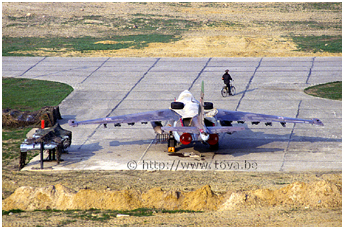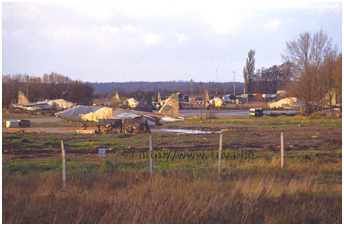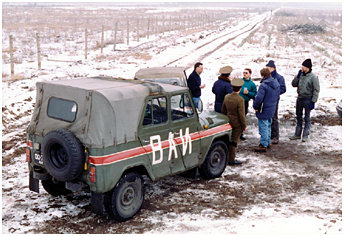 After several detours our little convoy stopped in front of the headquarter building where we parked the vehicles. The
commander carefully checked that the doors of our car were locked, one never knows. In the entrance hall of the building,
a large map in relief fixed on the wall was showing by the means of a thick red stripe, the successive mutations of the
368.OShAP, from USSR to East Germany, through Afghanistan. Under good escort we were taken to a bureau where, just like in
a B movie, we had to declare our identities, full names, addresses, ages and professions. The transcription of the Latin
letters our IDs into Cyrillic characters created problems for our hosts...
In the meantime a German interpreter had arrived. In the presence of the commander and several other officers, our
interrogation began, polite and almost friendly. The questions were clearly constructed to cross-check the information
that we provided. What seemed to worry our interrogators (interlocutors?) the most was not the fact that we had taken pictures
but that we could have made video recordings. Why? This is a mystery as we did not get any explanation for that. However, one
should imagine the scene: one officer asked the question in Russian to the interpreter, who translated it into German.
Jean-Luc, who was the only one of us to have a sufficient knowledge of the German language, then repeated the question in
French to Hugo or to Richard. Needless to say that our dialogue was as slow as laborious.
After several detours our little convoy stopped in front of the headquarter building where we parked the vehicles. The
commander carefully checked that the doors of our car were locked, one never knows. In the entrance hall of the building,
a large map in relief fixed on the wall was showing by the means of a thick red stripe, the successive mutations of the
368.OShAP, from USSR to East Germany, through Afghanistan. Under good escort we were taken to a bureau where, just like in
a B movie, we had to declare our identities, full names, addresses, ages and professions. The transcription of the Latin
letters our IDs into Cyrillic characters created problems for our hosts...
In the meantime a German interpreter had arrived. In the presence of the commander and several other officers, our
interrogation began, polite and almost friendly. The questions were clearly constructed to cross-check the information
that we provided. What seemed to worry our interrogators (interlocutors?) the most was not the fact that we had taken pictures
but that we could have made video recordings. Why? This is a mystery as we did not get any explanation for that. However, one
should imagine the scene: one officer asked the question in Russian to the interpreter, who translated it into German.
Jean-Luc, who was the only one of us to have a sufficient knowledge of the German language, then repeated the question in
French to Hugo or to Richard. Needless to say that our dialogue was as slow as laborious.
 Gradually, the situation seemed to evolve towards our liberation. But now, an unshaved individual dressed in well-worn sports clothes arrived at
the scene and called the commander in the hallway. We overheard a vivid discussion. The commander returned, bid us farewell and announced
that the interrogation would continue. But how did we end up in this mess? The less friendly person dressed in sport clothes -
that we suspected to be a political or intelligence officer - was now directing the interrogation. Same questions, same
difficulties. Our interrogators did not seem at ease now. Finally at 8.30 pm after deliberating with one another, they decided
to let us go... advising us to inform the guards of our presence when we arrive the next time. All this just for that!
At last, we were free and could not believe it. We looked at each other and got into our car, relieved but still slightly
traumatized by the few hours we just experienced. After leaving the base searching for a hotel for the night, we finally
realized that we had been taken prisoners by the former Soviet Army. And above all we did not even photograph the "Frogfoot"
in a decent way. But for sure, we would take revenge. Done on 15 June 1993 when we climbed over the barbed wire right before
the last Russian sentinels still present to capture the departure of the Su-25 from Tutow to Gross Dölln, on the eve of their
departure back to C.I.S.
Gradually, the situation seemed to evolve towards our liberation. But now, an unshaved individual dressed in well-worn sports clothes arrived at
the scene and called the commander in the hallway. We overheard a vivid discussion. The commander returned, bid us farewell and announced
that the interrogation would continue. But how did we end up in this mess? The less friendly person dressed in sport clothes -
that we suspected to be a political or intelligence officer - was now directing the interrogation. Same questions, same
difficulties. Our interrogators did not seem at ease now. Finally at 8.30 pm after deliberating with one another, they decided
to let us go... advising us to inform the guards of our presence when we arrive the next time. All this just for that!
At last, we were free and could not believe it. We looked at each other and got into our car, relieved but still slightly
traumatized by the few hours we just experienced. After leaving the base searching for a hotel for the night, we finally
realized that we had been taken prisoners by the former Soviet Army. And above all we did not even photograph the "Frogfoot"
in a decent way. But for sure, we would take revenge. Done on 15 June 1993 when we climbed over the barbed wire right before
the last Russian sentinels still present to capture the departure of the Su-25 from Tutow to Gross Dölln, on the eve of their
departure back to C.I.S.
Story of a lived adventure, an anecdote among others - many - self experienced or collected during the different tours around the Russian airbases in the former GDR.
 During four too short years, prowling along the Russian bases had become a common activity for some pugnacious West European
and even, as incredible as it may seem, Japanese aviation enthusiasts. It was not an activity devoid of surprises or dangers
although rarely. If the German law concerning the observation and photography of military aircraft around military
installations extended from 3 October 1990 on to the newly reunited Germany, the Russian troops who became objects of
curiosity, have had great difficulty in understanding this type of behaviour. Some of them went through it much faster, like
this soldier at Altes Lager, who collected business cards from Dutch spotters - probably a pervert, or that other soldier at
Gross Dölln who took evident pleasure to be photographed with visitors.
During four too short years, prowling along the Russian bases had become a common activity for some pugnacious West European
and even, as incredible as it may seem, Japanese aviation enthusiasts. It was not an activity devoid of surprises or dangers
although rarely. If the German law concerning the observation and photography of military aircraft around military
installations extended from 3 October 1990 on to the newly reunited Germany, the Russian troops who became objects of
curiosity, have had great difficulty in understanding this type of behaviour. Some of them went through it much faster, like
this soldier at Altes Lager, who collected business cards from Dutch spotters - probably a pervert, or that other soldier at
Gross Dölln who took evident pleasure to be photographed with visitors.
Deserted or not, the Russian bases in Germany presented sometimes very vague boundaries, which lead to controls and even arrests - just like the one described above - and even on some rare occasions, invitations to visit the military facilities. The different examples of such contacts were numerous. Sometimes dramatic, such as the bullet wound injury of a German soldier who tried to photograph too close a former storage site for nuclear weapons at Altengrabow, or more sympathetic, as in the case of these two French spotters (they will recognize themselves surely) who were spontaneously invited by some military personnel from Welzow to admire more closely the Sukhoï Su-24MR "Fencer-E", unfortunately for them without authorization to photograph. But it's true that after a long period of tight security around the airbase, Welzow had become progressively, after the departure of the Su-24MP "Fencer-F", an "open house". As the sole airbase of Su-24 and MiG-25 in Germany, Welzow attracted many enthusiasts for whom the barbed wire limitations of this facility quickly became very symbolic. They crossed the fences shamelessly to photograph the machines which were based here, almost always without provoking a reaction from the Russian soldiers who knew perfectly what was going on. A situation which seems quite particular now; just imagine that you penetrate the base perimeter of a NATO airbase to take pictures of aircraft based there. No doubts that you would be arrested on the base before you knew it, and subject of serious prosecution.
From these different experiences a general conclusion is needed and should be stated. Far from being the unfriendly, greedy or ideologically bounded persons - as they are too often portrayed by some debilitating Hollywood filmography - most Russian officers and soldiers whom we met were open minded, curious and willing to discuss, despite the enormous barriers that were the differences of language and political, social and economical cultures.
 |
Prisoners of the "Red Army" < Part 1 |
 |
Plan du site - Sitemap |  |

